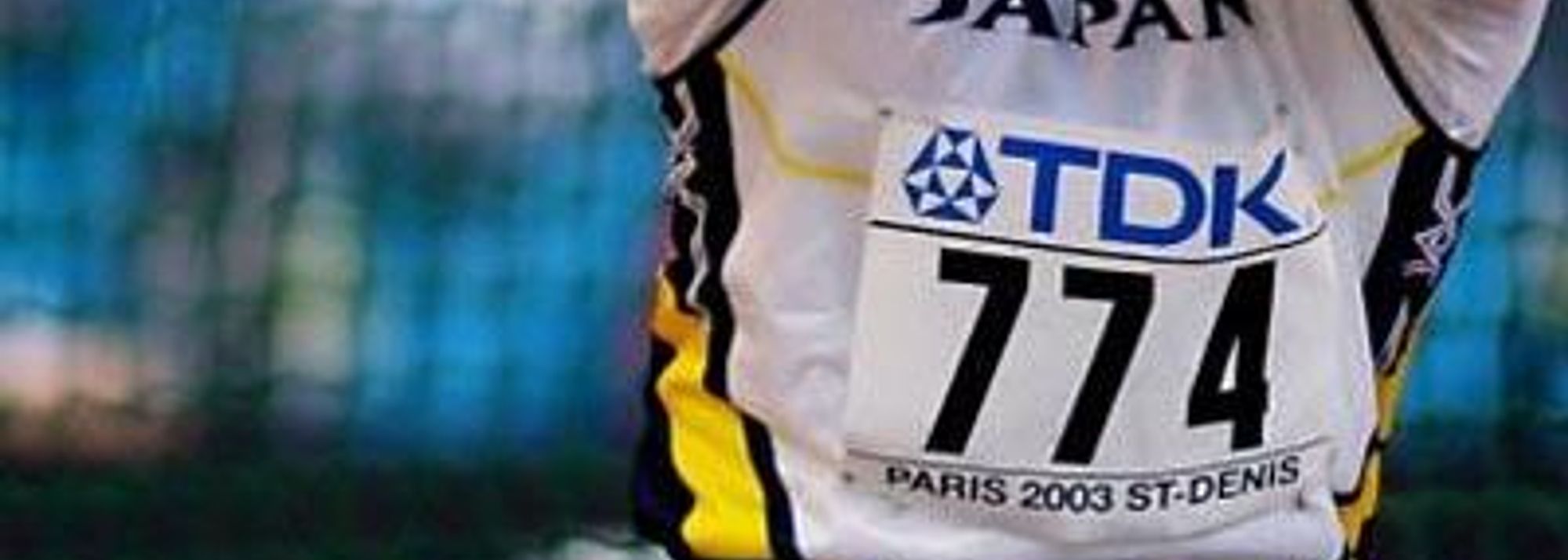Koji Murofushi of Japan finishes third in the men's hammer throw (© Getty Images)
How are you all? The 2003 track season is now history, and today I would like to write about my final two competitions of the season, the World Athletics Final in Hungary and the Super Meet in Yokohama. Furthermore I would like to write about the other aspects of my life, which are closely related to training and competitions.
After returning from the World Championships in Paris, I only had one week stay at my home before my departure for Szombathely, Hungary.
The purpose of my travel to Szombathely was two fold. In addition to the hammer throw competition at the World Athletics Final, I also intended to attend the Hammer Throw Summit, which was held in conjunction with the Final.
By attending the seminars and workshops in the Summit, I was looking for some insight to improve my training for the upcoming Olympic Games in Athens. In the Summit, many of the all-time great hammer throwers as well as coaches were in attendance; they came from all over the world.
It was very beneficial for me to listen to the great Olympic champions like Hal Connolly (1956 Olympic gold medalist), Gyula Zsivotzky (1968 Olympic gold medalist, 1964 Olympic silver medalist), Anatoliy Bondarchuk (1972 Olympic gold medalist) and Yuriy Sedykh (1976 and 1980 Olympic gold medalist, 1988 Olympic silver medalist and 1991 World Champion).
I noticed that the audience was especially interested in the lecture given by Anatoliy Bondarchuk. The subject of his talk was on the long term planning for training as well as peaking for the important competitions. Unfortunately, most of the audience in attendance was coaches and not active athletes. In fact, I was the only athlete in attendance at the Summit.
As for the competition, I felt that I was still feeling an ill effect of jetlag during the competition. Thus I did not throw very well, not because of any technical problems but because of general conditions including the problem of jet lag.
After returning from Hungary, on 23 September, I competed in the Super Meet in Yokohama. Not only was it my final competition of the year, but it is also one of my favourite competitions. In the Yokohama International stadium, I was able to reflect on the season and at the same time enjoy the competitions with my friends. As many people have noted, the weather was little on the cold side, however, the rain did not materialize, and thus I do not think the weather affected the performances very much.
Now that the 2003 season is over, it is time to reflect upon myself because I did not have such opportunity during the season. As a start I would like to study the ancient ideas on movement and how they can be applied to the current ideas on the same topic. The question is how to combine the ancient and modern ideas; how to fuse these ideas together. Then starting in December I plan to start my winter base training.
Upon returning from Hungary I had to go to Osaka immediately, for Kosei Inoue, my best friend, was competing in the World Judo Championships in Osaka. Kosei, on one hand is very particular about winning the competition, but he is also very enthusiastic about pursuing the art of Judo itself. He won all competitions with “Ippon” the Judo’s equivalent of KO in the boxing or foul in the wrestling. He has thus won the World Judo championships for the third time. Congratulation Kosei! He is making a great progress toward his Olympic goal. I too must work toward my Olympic goal.
On 27 September I went to Kumamoto (located in the Southern Island of Kyushu, the hometown of Shingo Suetsugu, the bronze medalist at the 200m in Paris) to listen to the series of lectures sponsored by the Japanese Society of Physical Education.
My main purpose for attending was to listen to the lecture by Dr. Lev Pavlovich Matveyev. The subject of his lecture was the long term planning on training as well as the method of peaking for the major championships. Later Mr. Yoshinori Kono, who is an expert on the ancient martial arts, also gave a talk, which I found quite interesting. He also demonstrated various body movements used in the ancient martial arts; they were quite unique and thus very interesting to watch. Incidentally, when he appeared with the traditional wear of “Hakama” (traditional trousers like wear) and “Geta” (traditional sandal like footwear) he looked like a real “Samurai”.
He looked quite impressive. His was very quick and looked unbeatable. I would imagine that in the medieval time when the warriors faced the matter of life and death everyday, this kind of Samurai warriors must have been abound everywhere. The strength including the mental strength of these warriors who survived during such an era must have been quite extraordinary. Through this symposium I have came to realize that even in our own country there is much to be learned, and thus my quest for such knowledge will continue.
I hope to see you again soon, perhaps next year again at the IAAF Online.
Koji




